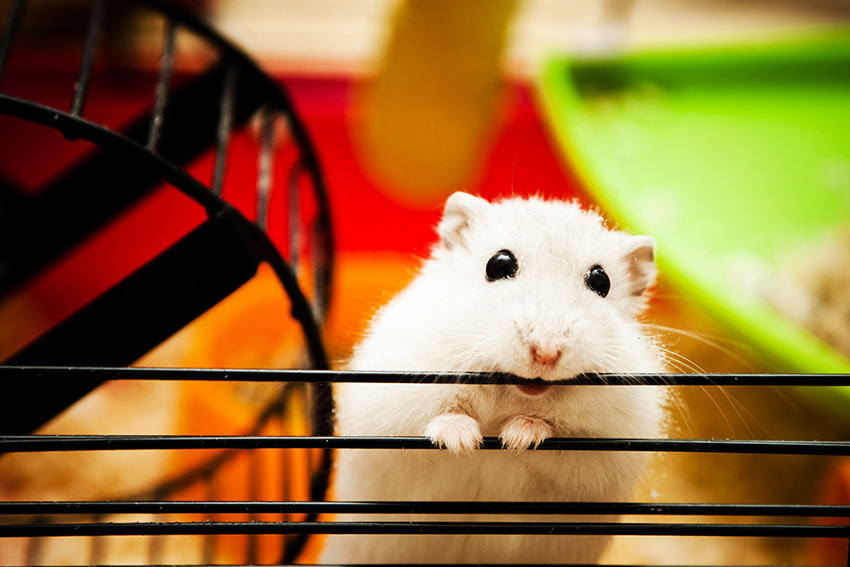It's commonly believed that metal bar-biting is a natural, and even a beneficial part of a hamster's life in a cage. This is not the case - and cage-biting can actually be detrimental to the animal's health.
If they regularly gnaw at the bars, hamsters can damage or even break their teeth. The habit can also lead to mouth and facial injuries, often through a condition known as bar-rub. Metal bars are not good for a hamster’s teeth - they’re far too hard, and will push the teeth out of their normal alignment.

Bar rub is one of the hazards of cage bar-chewing
A hamster that keeps biting the bars of its cage is lacking healthier forms of mental and physical simulation. The habit can also result from a hamster who lacks space, or who has overgrown teeth.
Hamsters are generally good at entertaining themselves. However, it is recommended that they are taken from their cage for some human interaction, and/or a session in the exercise ball, at least once every 24 hours. If you catch the hamster chewing the bars, intervene by taking it from the cage for some play time. You could then try increasing the frequency of these play sessions - again, a hamster exercise ball will take the pressure off you as the sole provider of fun!
if this fails to reduce the bar-chewing, there may be some issue with the hamster's teeth. If they are overgrown he might be driven to gnaw on the metal.
Give Your Hamster Something To Chew
Hamsters love to chew, so provide something good to chew on, to remove the temptation of the cage bars. Hamsters' teeth are constantly growing, and they need hard food and wooden chews in order to keep these teeth down to size. The cage bars are often a last resort, if there’s nothing else to chew on. If you feed your pet hamster pellets (which are quite soft), try changing to solid dry foods instead - that will help wear down the teeth.
Is There A Problem With Your Hamster Cage?
If you’ve tried the options mentioned above, with no good result, the problem may lie with the cage itself. Your hamster may simply be trying to escape from an enclosure that's too small. In the absence of an obvious way out, the only thing they can do is attempt to gnaw their way out. This problem is commoner than you might think, as cages intended for mice are often used in the mistaken belief that they are suitable for hamsters.
There are plenty of suitable cages available, many of them lacking bars altogether. A custom-made enclosure such as the Qute is ideal.
Comments
Brenda;, 23 February 2023
Please do not advise people to put their hamster in a ball. These are very dangerous. They do not provide enough ventilation, they are stressful for hamsters, and there have been numerous foot & toe injuries, sometimes with toes getting ripped off. These are very very dangerous.
Tuzzut, 18 October 2022
My new winter white dwarf hamsters keep chewing on their cage bars.. I've only had them for like 3 days and I'm not sure what to do. They have this small petshop cage cause my parents wouldn't allow me to get a bigger one. They just say that it's fine and i should let them bite it,but I'm worried about their teeth and such
Malia, 21 August 2022
I got a hamster 3 days ago, I was super excited! My parents had hamsters when they were younger so I thought I was ready, but soon, my hamster started to bite it’s cage A LOT. So yesterday (My second day of having her) it was late at night, (2:00 AM) and I was with my brother near the hamster cage, we were petting her gently and she was fine, but soon later, she started to bite the cage so much. We thought it was normal, so we let her for a bit, but then, we noticed some paint was coming off the bars, I looks from the other side and I noticed the whole entire bar was coming off, I am going on a trip in a few days, and I’m really scared she will escape, and if not while we’re on the trip, she will still probably escape before Summer break ends. I’m really scared, what can we put on the bars to make sure she doesn’t break them? Please answer, I just got her and she’s already about to escape…
Amie, 31 May 2021
I have 2 robos. One just escaped his cage, I have no idea how and I didn’t even hear or notice it happen and was even in the room! I found out that they seem to be running on the wheel as though they were trying to get to the bars to climb them. When I moved the wheel, they did the same, except they fell off the other side of the wheel instead (saucer wheel). In a panicked fear they might escape again, I’ve cooled their playpen around the bars and pray they don’t get out while I sleep. I do feel that the cage is too small but I have to wait a week before I can purchase one...anyone have advice for what I can do in the meantime to ensure they don’t escape??
Choi, 25 May 2021
@Téa still it’s too small for Syrian the minimum is 450 inch squared floor space. Try 30 by 18 cage or bigger.